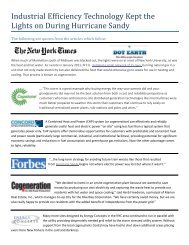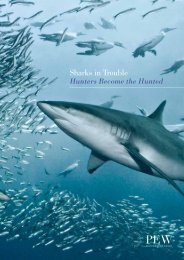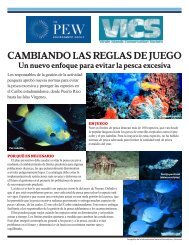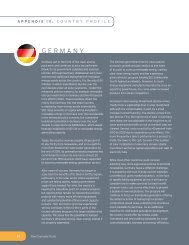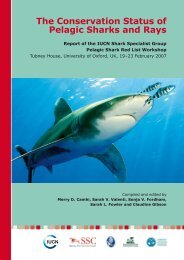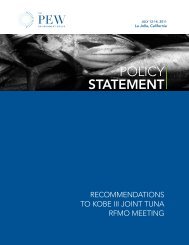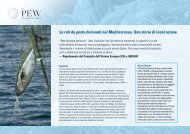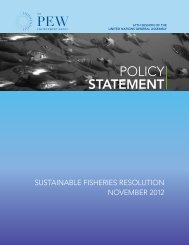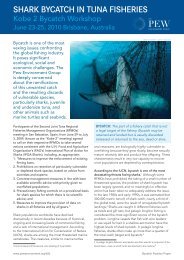The Law That's Saving American Fisheries - Ocean Conservancy
The Law That's Saving American Fisheries - Ocean Conservancy
The Law That's Saving American Fisheries - Ocean Conservancy
You also want an ePaper? Increase the reach of your titles
YUMPU automatically turns print PDFs into web optimized ePapers that Google loves.
Al Burch<br />
Paying attention to science delivers long-term payoff<br />
limits designed to protect the population once the stock<br />
grew large enough to support some landings.<br />
<strong>The</strong> North Pacific council used a tiered system for setting<br />
limits based on how much information scientists had on<br />
hand: the less information, the more stringent the limits.<br />
Since red rockfish came under the council’s rebuilding<br />
plan, the spawning stock biomass of this deep-dwelling<br />
species has tripled. 57<br />
Al Burch, who trawls for Pacific ocean perch,<br />
welcomes the onboard observer program.<br />
“It kept us in business,” he said.<br />
FACES of the Kodiak<br />
King Crab Fishery<br />
Collection, Kodiak<br />
Maritime Museum<br />
Nearly 50 years ago, Al Burch was crabbing in the Gulf<br />
of Alaska when he and his brother looked up to see<br />
a gigantic Russian factory ship looming near. “It was<br />
stacked high with something red on deck, and they had crab<br />
pots hanging over the side,” Burch recalls. “We started chasing<br />
them. Even going full speed, we couldn’t make much headway<br />
on them. We got close to them, though, and it was Pacific<br />
ocean perch that they had on board.”<br />
Burch was witnessing one of the Soviet Union’s most harmful<br />
exports: an armada of freezer trawlers raiding distant seas.<br />
<strong>The</strong> long-lived, slow-growing ocean perch, sometimes called<br />
red rockfish, were no match for this unprecedented industrial<br />
fishing pressure. A coordinated fleet of more than 100 Soviet<br />
freezer trawlers systematically hauled away most of the<br />
near-virgin stocks of this species. <strong>The</strong>ir job done, the Russians<br />
steamed away. <strong>The</strong>n Japanese factory trawlers took what<br />
was left.<br />
Burch joined the fight to drive out the foreign fleets, and<br />
after passage of the Magnuson-Stevens Act, he spent decades<br />
helping to nurse the depleted perch resource back to health.<br />
<strong>The</strong> fishery, which was fully domestic beginning in 1991,<br />
came under a rebuilding plan in 1994 to repair the damage<br />
from foreign overfishing. As a leader of Kodiak’s trawl fleet<br />
and a long-serving member of the North Pacific Fishery<br />
Management Council’s groundfish advisory panel, Burch<br />
supported—and endured—a long string of bans, bycatch rules<br />
to protect perch, area closures, and, eventually, tight catch<br />
<strong>The</strong> catch limits were used in combination with monitoring,<br />
area closures, and tough bycatch limits on other rockfish<br />
species associated with Pacific ocean perch. Research<br />
continues today to improve estimates of the population, to<br />
better understand its structure, and to enhance information<br />
on how habitat and predation affect juvenile perch. 58<br />
Today, Burch’s two boats and other trawlers from Kodiak are<br />
fishing again on the rebuilt Pacific ocean perch. Allowable<br />
catches have steadily increased, reaching nearly 41.9 million<br />
pounds in 2012. A novel cooperative system permitted under the<br />
Magnuson-Stevens Act allowed the fishermen to extend their<br />
season from three weeks to more than six months, and trim<br />
bycatch rates that constrained their access to available rockfish<br />
quota. <strong>The</strong> fleet’s earnings from the species doubled by 2007.<br />
By sharing data to avoid bycatch “hot spots,” the fleet targets<br />
the available perch while steering clear of areas found to<br />
be full of off-limits species such as salmon. “<strong>The</strong> hot-spot<br />
authority works,” says Burch. “We’re using that in the Pacific<br />
ocean perch fisheries a lot.”<br />
One key to the Kodiak trawlers’ success is their embrace<br />
of observer coverage. Data from independent scientific<br />
observers allow fishermen to manage catches precisely—and<br />
to fend off unfounded criticism. “It doesn’t sound like the<br />
East Coast is too happy with it, but, boy, we sure are here,”<br />
Burch says. “It kept us in business.”<br />
Beginning more than two decades ago, Burch’s fleet didn’t just<br />
accept observers onboard the boats; it lobbied to get them.<br />
<strong>The</strong> aim? To disprove allegations that the fleet was raking up<br />
large quantities of bycatch and destroying vulnerable corals.<br />
Once independent observer data were available, the rhetoric<br />
cooled, he says. “<strong>The</strong>y had to prove their statements. <strong>The</strong>y<br />
became a lot more careful.”<br />
34 It’s a Keeper



